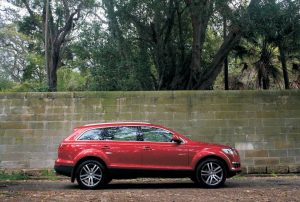Recalls: Audi 4L Q7
Overview
Manufacturers, or importers, issue recalls for defects or faults which have the potential to cause injury. Generally, manufacturers will inform the original buyers if their vehicle is subject to a recall and of the steps required to remedy the defect or fault. Please note that the recalls below (if any) are for Australian-delivered vehicles only. Furthermore, the number of recalls should not be taken as an indication of a model’s reliability or its safety more generally.
Recalls: Audi 4L Q7
Audi 4L Q7: tailgate may close unexpectedly
In October 2007, a recall was issued for Audi 4L Q7 due to the power-operated tailgate potentially closing unexpectedly and abruptly shortly after being opened using the power function – this posed a risk of injury to persons when loading or unloading the vehicle and could be remedied by a software update (PRA 2007/9542).
2011-12 Audi 4L Q7 3.0 TFSI: fuel leak
In January 2015, a recall was issued for Audi 4L Q7 models with the 3.0 TFSI engine that were manufactured from April 2011 to April 2012 (inclusive). In these vehicles, a fuel leak may occur at the connection between the fuel rail and the injector. If this occurred, the owner may detect a fuel smell from the engine compartment and leaking fuel could pose a fire hazard in the presence of an ignition source. As part of the recall, the fuel rail was to be replaced and a reinforced retaining bracket fitted (PRA 2015/14530).
Problems and faults: Audi 4L Q7
Overview
This section identifies potential problems, causes and fixes based on the experiences of owners and repairers, online sources and technical service bulletins. This information is provided solely for reference purposes and AustralianCar.Reviews recommends that only properly qualified persons carry out repairs or modifications. Furthermore, the number of items below should not be taken as an indicator of a model’s reliability or the frequency with which they may occur.
To report a problem or fault to the AustralianCar.Reviews team, please use the Contact Us form. Note that AustralianCar.Reviews does not offer advice on automotive problems or disputes; such enquiries will not receive a reply. For vehicles purchased from dealers after 1 January 2011, please see our Australian Consumer Law fact sheet.
Audi 4L Q7 3.0 TFSI: rattling noise from timing chain on start-up
In 27 April 2016, Audi issued Technical Service Bulletin 15 16 28 2039995/2 for 2011-15 model year Audi 4L Q7 3.0 TFSI vehicles. In these vehicles, rattling noises may be heard from the timing chain drive (at the back of the engine) for around 1-3 seconds after the first engine start of the day. According to the bulletin, these noises were caused by one of the upper chain tensioners, but did not lead to damage. To fix, both upper chain tensioners of bank 1 and bank 2 were to be replaced with ‘optimised’ chain tensioners. The part numbers were as follows –
- Chain tensioner for bank 1: part number 06E109218AJ; and,
- Chain tensioner for bank 2: part number 06E109217AH.
Audi Q7 3.6 FSI and 4.2 FSI: carbon deposits (build-up) on intake valves
Audi’s naturally aspirated, direct injected petrol engines (such as the Q7’s 3.6 FSI and 4.2 FSI) are considered susceptible to accumulating carbon deposits (or build up) on the intake valves. In these direct injection petrol engines, carbon deposits may accumulate on the stem and throat of the intake valve due to:
- the vaporisation of oil which is not trapped by the oil separator; or
- unburned fuel and exhaust gases that escape past the piston rings and enter the crankcase (‘blow-by’).
Since direct injection engines do not spray fuel on the backside of the intake valves, the detergent properties of the fuel cannot remove the carbon build up (as occurs in port injected engines). Symptoms of carbon deposits on the intake valve include difficulty starting the vehicle (hard starting), misfiring and misfire engine codes and reduced engine performance. Potentially, these deposits can result in damage to the catalytic converter and, for turbocharged engines, the turbocharger itself if bits of the deposit break off and enter the exhaust. To remove the carbon deposits, the intake must be removed and the valves cleaned manually. To reduce the incidence of carbon deposits, a common aftermarket measure is the fitment of an oil vapor catch can. The catch can receives dirty air from the crankcase via the Positive Crankcase Ventilation (PCV) valve, filters it and returns it to the intake manifold via the PCV port.
Audi 4L Q7 3.6 FSI & 4.2 FSI: low-pressure fuel system sensor
In March 2008, Audi issued technical service bulletin 2015106/4 for 2006-08 Audi 4L Q7 3.6 V6 FSI and 4.2 V8 FSI vehicles. In these vehicles, the Malfunction Indicator Lamp (MIL) may illuminate and the following diagnostic trouble codes (DTCs) may be logged –
- P310B: low-pressure fuel system regulation, fuel pressure outside tolerance; and,
- P129F: low-pressure fuel system, pressure too high.
According to the service bulletin, this condition may be caused by fuel intrusion into the low-pressure system fuel pressure sensor (G410), such that a false signal that was out of tolerance was sent to the controller. Subsequently, improvements were made to the G410 fuel pressure sensor.
Audi Q7 V6 diesel engine: NOx emissions “defeat device”
Audi 4L Q7 vehicles powered by 3.0-litre diesel V6 engines (engine codes: BUG/CASA/CJGA) that were available for sale from 2009 to 2014 have software in the electronic control module (ECM) that can sense – via sensors measuring the position of the steering wheel, vehicle speed, the duration of the engine’s operation and barometric pressure – when the vehicle is undergoing emissions testing. The ECM then operates in a low NOx “temperature conditioning” mode to satisfy emissions standards.
At exactly one second after the completion of the initial phases of the standard test procedure, the software immediately switches to a “normal mode” and changes a number of operating parameters that increased NOx emissions. In other tests where the vehicle did not experience driving conditions similar to the start of the emissions testing procedure, the emissions were higher from the start, consistent with the operation and existence of a “normal mode”.
The software on these vehicles constitutes a “defeat device” since it is an Auxiliary Emissions Control Device (AECD) designed to circumvent emissions testing. Volkswagen has admitted that all its 3.0-litre turbo-diesel engines from ‘model years’ 2009 through to 2016 have defeat devices.
Problems and faults: Audi 4L Q7
- Vibrations in the steering wheel vibrations may be due to a front driveshaft imbalance.
- For early models, the ‘check engine’ light may illuminate and there may be an error code for the fuel system due to fuel leaks in the fuel pressure sensor – an improved part was subsequently released to fix this problem.
- For models with dual-zone air conditioning, a cold air leak may be felt at the B-pillar door gap due to a loose grille in the B-pillar.
- Where fitted, the rear sunroof may reverse direction when closing due to the shade being jammed and creating resistance. Water may also leak from the sunroof if the drain hose is kinked or plugged or if there is insufficient sealing of the corners during production.
- For models that have had their windscreens replaced, the automatic headlights may switch on or off too quickly, too slowly or even randomly if the replacement was not carried out correctly.




